calsfoundation@cals.org
Civil War Timeline
| 1860 | ||
| Secession | ||
| August 6 | Henry Massie Rector was elected as the sixth governor of Arkansas, defeating the candidate of the political dynasty known as “The Family,” Richard H. Johnson. | |
| November 15 | Rector was inaugurated as governor. In Rector’s first speech before the Arkansas legislature, the governor flouted Abraham Lincoln’s election as president and called for the dissolution of the Union. This view was considered somewhat radical by many Arkansans, though seven other Southern states would approve measures for secession by early February. These states were South Carolina, Mississippi, Florida, Alabama, Georgia, Louisiana, and Texas. Later in November, Captain James Totten and sixty-five federal soldiers garrisoned the federal arsenal in Little Rock (Pulaski County). | |
| December 22 | The Arkansas House of Representatives approved legislation proposing a convention for secession. | |
| 1861 | ||
| January 16 | The Arkansas Senate approved the House bill for a secession convention. In late January, a rumor began to spread that Federal troops were on their way to reinforce the arsenal in Little Rock. A public meeting was held in Helena (Phillips County) to discuss the rumor, and attendees resolved to seize the arsenal themselves. Governor Rector, hearing the rumor himself, informed Captain Totten that destruction of arms or reinforcement of the arsenal would result in conflict. | |
| February 1 | After another rumor surfaced that Federal troops were headed up the Arkansas River toward Little Rock, Governor Rector called for volunteers to help defend against the invasion. However, the rumor proved false. | |
| February 5 | Volunteers began to arrive in Little Rock under the impression that they were to seize the arsenal from Federal forces. | |
| February 6 | Governor Rector sent a note to Captain Totten requesting his surrender of the arsenal. | |
| February 8 | Captain Totten and his men abandoned the arsenal, evacuating Little Rock. | |
| February 18 | A referendum was held on the topic of secession, with voters approving a secession convention but denying secession itself. | |
| March 4 | The Arkansas Secession Convention, led by a pro-Unionist majority, convened in Little Rock. | |
| March 18 | A vote on secession was finally held, with the move being defeated 39–35 by the pro-Union faction. Though secession was defeated, secessionists were given a concession by scheduling another public referendum for August 5, 1861. | |
| April 12 | Confederate forces fired on Fort Sumter in South Carolina. When Lincoln called upon Arkansas for volunteers, Governor Rector ironically responded that “the people of this commonwealth are freemen, not slaves, and will defend to the extremity their honor, lives, against Northern mendacity and usurpation.” | |
| April 23 | Governor Rector called for a militia to seize Fort Smith (Sebastian County), but upon arrival, the militia found the fort abandoned by Federal forces. | |
| May 6 | David Walker, chairman of the Secession Convention, reconvened the convention to vote once again on secession. Virginia had recently joined the seven other Southern states of the Confederacy, helping to pave the way for Arkansas’s secession from the Union. The decision was nearly unanimous for secession, with the lone dissenting vote having been cast by Isaac Murphy. Murphy would later serve as Arkansas’s first governor during Reconstruction. | |
| May 11 | A political war broke out between Governor Rector and the Secession Convention as to who held authority in the ceded state. The convention created a military board to command the state’s armed forces, though many members of the militia refused to follow the board’s orders. | |
| June 3 | Against its will, the Secession Convention finally adjourned, but political turmoil would continue in Confederate Arkansas. General William J. Hardee was assigned to command Confederate forces in Arkansas, but many soldiers did not wish to join the regular army and risk being moved away from their home state. A lack of organization or cohesive command plagued Arkansas for the remainder of 1861. | |
| November 17 | The nearly unanimous vote for secession in the state legislature was hardly representative of Arkansan opinion, particularly in the northwestern part of the state. By late 1861, Unionist organizations were created and merged to form the clandestine Arkansas Peace Society. The society was first discovered by Confederate authorities when it was betrayed on November 17 in Searcy County. Suspected members were arrested throughout northern Arkansas, with most opting to join the Confederate army rather than face trial for treason. Governor Rector wrote that, at its peak, the organization consisted of more than 1,700 members scattered throughout the mountainous northern counties of Arkansas. | |
| 1862 | ||
| Pea Ridge Campaign | ||
| Action at Pott’s Hill | ||
| Skirmish at Little Sugar Creek | ||
| Action at Bentonville | ||
| Battle of Pea Ridge | ||
| Action at Spring River | ||
| Action at Whitney’s Lane | ||
| Engagement at St. Charles | ||
| Action at Hill’s Plantation | ||
| January 10 | In an effort to establish order, General Earl Van Dorn was assigned by the Confederacy to take over command in the Trans-Mississippi Theater. Union brigadier general Samuel Curtis, along with 12,000 men, had begun to drive Confederate forces south from Missouri, thus initiating the Pea Ridge Campaign. | |
| February 16 | With General Curtis in pursuit, General Sterling Price led the retreating Confederate army across the Arkansas state line near Bentonville (Benton County). In the first military engagements of the Civil War in Arkansas, the two armies clashed in the Action at Pott’s Hill and the Skirmish at Little Sugar Creek. On February 18, the two forces fought again in the Action at Bentonville, resulting in a continued Confederate retreat southward. These relatively minor conflicts were precursors to the largest battle of the Civil War fought in Arkansas, the Battle of Pea Ridge. | |
| March | In response to the Confederate expulsion from Missouri, General Van Dorn devised a plan to attack Union forces in northwest Arkansas as part of an effort to move north and capture St. Louis. From his headquarters in Pocahontas (Randolph County), General Van Dorn moved to northwest Arkansas, amassing a force of 16,000 men. | |
| March 4 | At the suggestion of General Ben McCulloch, General Van Dorn ordered his men on a large nighttime flanking maneuver around the Bentonville Detour. Though the maneuver was successful in getting a portion of Van Dorn’s men behind the Union forces, General Curtis was able to slow the Confederate flank and prepare his forces for a morning attack from the north side of camp. | |
| March 7–8 | Battle of Pea Ridge: Union and Confederate forces fought over the next two days near a plateau known as Pea Ridge. Union forces, led by General Curtis, were successful in recapturing territory lost during the initial Confederate offensive. Confederates suffered 2,000 casualties, including General McCulloch, Brigadier General James McQueen McIntosh, and Brigadier General William Slack. Union forces emerged victorious, losing 1,384 men. The Battle of Pea Ridge was an important defense of Missouri for the Union, which would control it for the next two years. In defeat, General Van Dorn was called east by the Confederate command, leading his troops and all supplies across the Mississippi River. | |
| March 13 | Action at Spring River: In the wake of the Battle of Pea Ridge, Union cavalrymen attempted to clear Missouri and the northern portion of Fulton County of any remaining Rebel resistance. They encountered an informal force of 600 to 1,000 men led by Colonel W. O. Coleman, J. Posey Woodside, and Colonel Archibald MacFarlane. Confederate forces were unable to regroup into a single regiment as they were defeated, losing approximately 100 men. Union forces, led by Lieutenant Colonel Samuel Wood and Major William Drake, experienced twenty-three casualties. | |
| April 15 | The Arkansas Confederate congressional delegation requested that Jefferson Davis return Arkansas’s forces back to Arkansas. Most of Arkansas’s defenses had been pulled east following the defeat at the Battle of Pea Ridge. | |
| May | General Thomas Hindman was appointed commander of Arkansas. He arrived in Little Rock to find that the state had virtually no remaining soldiers or supplies. General Hindman ordered Brigadier General Albert Pike to move his forces from a defense of the Indian Territory (now Oklahoma) to aid the defense of Little Rock. In addition to this, Hindman promoted the formation of irregular, guerrilla-like units to stifle Curtis’s army. Such units, known as bushwhackers or jayhawkers, terrorized many parts of Arkansas during the war, attacking Union and Confederate troops as well as civilians. | |
| May 19 | Action at Whitney’s Lane: While on a foraging expedition near Searcy (White County), a Union detachment was attacked by Texas cavalry and local militia. Following this small but fierce conflict, General Curtis gave orders for Union forces no longer to take bushwhackers prisoner. As Union forces had begun to move south toward Little Rock, Governor Rector grew worried and evacuated the state government from the capital city. An informal defense of the city was generated, primarily by local militia and Texan soldiers. The Union army, which had been slowed by the Confederate victory at Whitney’s Lane, decided not to attempt to capture Little Rock. Governor Rector would eventually return to the city by the end of the month. Union forces instead moved east, freeing slaves and destroying property along the way. | |
| June | Rebel bushwhackers continued to disrupt Union supply lines, and in response, Union major general Henry Halleck asked the U.S. Navy to supply the Curtis’s army via flotilla up the White River. | |
| June 17 | Engagement at St. Charles: En route to St. Charles (Arkansas County) to supply Curtis’s army, the Union flotilla was attacked by Rebel forces. Confederate batteries fired upon the Union gunboats, prompting a Union infantry force to disembark upon the Confederate position. The USS Mound City suffered extensive damage, with the crew of the ship experiencing 149 casualties. The advance of the gunboats was halted as a Union infantry force closed on the Rebel forces. The Confederates were overcome, and the remnants of the flotilla continued on, though they were never able to supply Curtis’s Army of the Southwest. | |
| June 30 | Major General Hindman declared martial law across the entire state. | |
| July 7 | Action at Hill’s Plantation: Unable to obtain supplies from the flotilla, General Curtis cut his supply lines from Rolla, Missouri, and marched toward Clarendon (Monroe County). General Hindman sought to disrupt this move to a new supply base and ordered General Albert Rust to lead an army of 5,000 men to confront Union forces at the Cache River. Union forces won in a lopsided victory, losing just sixty-three men, while Confederate forces suffered 250 casualties. Curtis moved on to Clarendon, only to learn that a second flotilla had just departed up the Mississippi. Curtis and his army moved to Helena to await supplies. This move marked the end of the Pea Ridge Campaign. Though the Union had won numerous decisive victories over the Confederates, Little Rock remained under Confederate control. | |
| Skirmish at Jonesboro | ||
| August 1–2 | Skirmish at Jonesboro: In the wake of the Pea Ridge Campaign and the fall of Memphis, Tennessee, northeast Arkansas was largely controlled by Union forces. Confederate defenses began to arise from local militias and troops scattered behind enemy lines. The Skirmish at Jonesboro was one instance of conflict between these informal Confederate forces organized to fight the Union occupiers. Led by Captain Mitchell Adair, Confederates survived a surprise attack led by Union lieutenant Charles Porter on August 1, mounting a raid the following morning. The raid was successful, with Federals suffering eleven casualties and the Confederates only one. The Federals were forced out of Jonesboro, with the Confederates regaining captured troops and supplies lost during the initial attack. | |
| Skirmish at L’Anguille Ferry | ||
| August 3 | Skirmish at L’Anguille Ferry: Seeking to avenge the defeat at Hill’s Plantation, Confederate colonel William Henry Parsons led 600 Texas cavalrymen in the Skirmish at L’Anguille Ferry. The Union forces, advancing south to aid in the defense of Helena (Phillips County), were caught off guard and thoroughly defeated. Union losses amounted to seventeen dead, forty wounded, twenty-five captured, and eight missing. Confederates suffered eleven casualties. The Confederate victory contributed to Union forces staying near the Mississippi River during the following year. | |
| Skirmish at Pitman’s Ferry | ||
| October 27 | Skirmish at Pitman’s Ferry: Led by Colonel William Dewey, a Union army launched an attack upon Confederate forces near Pitman’s Ferry in Randolph County. A key crossing along the Current River, the ferry was temporarily seized by Union forces. Federal accounts claim that forty Confederate soldiers were taken prisoner, while there is no known Confederate record of the skirmish. | |
| Prairie Grove Campaign | ||
| Engagement at Cane Hill | ||
| Battle of Prairie Grove | ||
| Capture of Van Buren | ||
| November 14 | Harris Flanagin became Arkansas’s seventh governor, defeating the incumbent Henry Rector. The Secession Convention had shortened Rector’s term from four years to two, prompting the premature election. Despite this change in leadership, the government in Arkansas would continue to fall under the control of the military. | |
| November 28 | Engagement at Cane Hill: The Engagement at Cane Hill was the beginning of the Prairie Grove Campaign. The Union Army of the Frontier, led by General John Schofield, had advanced south through Missouri during the fall of 1862. Returning to Missouri, Schofield left behind a portion of the Army of the Frontier in northwest Arkansas. Under the command of Brigadier General James Blunt, 5,000 Union soldiers attacked a force of 2,000 Confederates at Cane Hill. Though Blunt and the Union captured Cane Hill, there were few casualties on either side. The engagement was significant in that it set the stage for one of the larger battles of the Civil War in Arkansas, Hindman’s attack of the Army of the Frontier. | |
| December 7 | Battle of Prairie Grove: Major General Hindman, who was encamped at Fort Smith, set off with 12,000 soldiers northward to attack Blunt’s new command at Cane Hill (Washington County). Blunt learned of Hindman’s move north and requested reinforcements from the rest of the Army of the Frontier. Blunt’s request was met by Brigadier General Francis Herron, who marched an incredible 110 miles in just three days. The forces pummeled one another with artillery attacks, and though neither side won, Hindman and his forces retreated to Van Buren (Crawford County). Union forces experienced 1,251 casualties, with Confederates having 1,317. | |
| December 28 |
Capture of Van Buren: Union generals James G. Blunt and Francis J. Herron began an expedition toward Van Buren later in the month to pursue Hindman, whose own troops were demoralized and ill. Hindman determined that it was impossible to find subsistence and forage for his men and the horses, so he began to send other divisions to areas along the river east of his current location. Union forces were able to take Van Buren, a strategic site, with minimal effort, but retreating Confederates blasted the city with artillery as they left. | |
| 1863 | ||
| Operations against Vicksburg | ||
| Battle of Arkansas Post | ||
| Battle of Helena | ||
| January 9–11 | Battle of Arkansas Post: General Ulysses Grant, in response to repeated attacks upon Federal supply ships, appointed General John McClernand to secure the Mississippi River for the Union. With a force of 33,000 soldiers, including 1,000 cavalrymen, McClernand moved upriver toward Fort Hindman at Arkansas Post (Arkansas County). Disguising his movement, McClernand entered at the mouth of the White River, rather than the Arkansas River. By the afternoon of January 9, Brigadier General Thomas J. Churchill became aware of the Union advance and prepared 5,000 Confederate troops at the fort for battle. The fort along the banks of the Arkansas River was bombarded throughout the afternoon of January 10, with it being too dark for the Union infantry to attack at the end of it. Attacking with full force on January 11, Union troops overwhelmed the Confederate defenses. Though the Union suffered 1,061 casualties and the Confederates had lost just 140, white flags started popping up along the lines as Federal troops prepared for a final frontal assault, and Confederate General Churchill felt that he had no honorable choice but to surrender. The remaining 4,791 troops were taken captive and sent up the Mississippi River to be held at prison camps. The defeat cost Confederate Arkansas nearly one-fourth of its troops. | |
| July 4 | Battle of Helena: Lieutenant General Theophilus H. Holmes was appointed the new commander of Confederate forces in Arkansas. Holmes had devised a plan to regain momentum in Arkansas through a decisive victory against the Union base in Helena. Forces defending Helena had been depleted in order to aid Grant’s siege of Vicksburg, Mississippi. Union major general Benjamin Prentiss, who was notified of the Confederate advance, led 4,129 troops in defense of Helena. On July 4, 7,646 Confederates attacked the heavily fortified city. The attack was unorganized and futile, with Confederates suffering 1,614 casualties. Union forces, which did not pursue the retreating Rebels, lost 239 men. This came one day after the Confederate defeat at Gettysburg and on the same day that Vicksburg fell to Union forces. | |
| Marmaduke in Northeast Arkansas | ||
| Skirmish at Chalk Bluff | ||
| Skirmish at Taylor’s Creek | ||
| May 1–2 | Skirmish at Chalk Bluff: In late April, Brigadier General John S. Marmaduke led Confederate cavalrymen in a raid into Federal-controlled Missouri. This raid was eventually repelled, and the raiders were forced to retreat by Union brigadier general William Vandever’s Second Division of the Army of the Frontier. At the orders of General Vandever, Brigadier General John McNeil pursued the Confederates south back into Arkansas. Marmaduke fled in a fighting retreat, setting up defensive positions just north of Chalk Bluff in Clay County. These defenses provided just enough time for Confederate forces to cross the St. Francis River. Though the battle was a tactical victory for the Confederacy, Union forces ended Marmaduke’s expeditions north and solidified their control of Missouri. The number of casualties is unknown. | |
| May 12 | Skirmish at Taylor’s Creek: Confederate general John S. Marmaduke received word that a Union force of 1,200 men was advancing north toward a Confederate regiment west of the L’Anguille River. Marmaduke led 1,400 mounted troops from Confederate headquarters at Jacksonport (Jackson County) north to head off the Federal army. Confederate forces were successful in halting the Union advance but were unable to inflict significant damage. Confederates lost fourteen men, while Union forces lost twenty-nine. | |
| Northwest Arkansas and the Indian Territory | ||
| Action at Fayetteville | ||
| Action at Devil’s Backbone | ||
| April 18 | Action at Fayetteville: Confederate brigadier general William L. Cabell led 900 cavalrymen north to retake the town of Fayetteville (Washington County), which had been used as a Federal outpost during the Battle of Prairie Grove. Confederates managed to lose the element of surprise and were significantly outgunned and unable to defeat Colonel Marcus LaRue Harrison and the Union forces. Just days after the Confederate withdrawal, Union commanders ordered Fayetteville abandoned. Both sides lost approximately fifty men during the conflict. | |
| September 1 | Action at Devil’s Backbone: Major General James Blunt worked his way back into Arkansas, having driven Confederate forces south into Indian Territory. Blunt turned toward Fort Smith. After skirmishing with Confederates led by Brigadier General William L. Cabell, Blunt captured the fort. Cabell and his force of 1,250 men retreated, with Union forces led by Colonel William F. Cloud in pursuit. Cabell turned at Devil’s Backbone and assembled an ambush on the pursuing Federal army. The ambush was largely ineffective, as Confederates had been suffering from severely low morale. Federal forces lost sixteen men, while the Confederates suffered sixty-five casualties. Fort Smith would remain a Union outpost for the remainder of the war. | |
| Little Rock Campaign | ||
| Skirmish at Brownsville | ||
| Action at Bayou Meto | ||
| Engagement at Bayou Fourche | ||
| August | Under the command of Frederick Steele, 6,000 Union soldiers began a march from Helena toward Little Rock that began the Little Rock Campaign. The army was joined at Clarendon by 6,000 cavalrymen under Brigadier General John Wynn Davidson and would continue to grow as it approached Little Rock. | |
| August 25 | Skirmish at Brownsville: Moving west from Clarendon, Union brigadier general John Wynn Davidson’s cavalry encountered its first resistance at Brownsville (Lonoke County), just northeast of Lonoke (Lonoke County). The 1,300 Confederate cavalrymen, led by Brigadier General Marmaduke, were outnumbered four to one and, as such, only temporarily slowed the Federal advance. Marmaduke would withdraw to Bayou Meto, where fighting would continue two days later. | |
| August 27 | Action at Bayou Meto: Brigadier General Davidson and his cavalry approached Confederate defenses at Bayou Meto, near present-day Jacksonville (Pulaski County). The Confederates, led by Brigadier General Lucius M. Walker, retreated across Reed’s Bridge, fooled into thinking that they were facing infantry as well as cavalry. Forty-five Union soldiers were lost, while the number of Confederate casualties is unknown. | |
| September | Brigadier General Marmaduke asked for a release from the command of Brigadier General Walker following the Confederate defeat at Bayou Meto. Walker, who believed Marmaduke viewed his retreat as cowardice, challenged Marmaduke to a duel. Marmaduke accepted, fatally wounding Walker during the dispute. | |
| September 10 | Engagement at Bayou Fourche: Brigadier General John Davidson and his cavalry moved across the Arkansas River to attack Little Rock from the southeast, while other Union forces attacked from the north side of the river. Davidson’s cavalry, led by Union commanders Colonel Lewis Merrill and Colonel J. M. Glover, met opposition at Bayou Fourche at the edge of Little Rock. Aided by artillery from the north side of the river, Union troops forced back Colonel Archibald Dobbins and the Confederate defense. Also defeated on the north side of the river, the Confederate army was forced to abandon the city of Little Rock and flee southwest. Federal casualties totaled seventy-two, while the number of Confederate casualties is unknown. For the first time in the war, the Union held complete control of the Arkansas River. Following the defeat, the Arkansas Confederate capital was moved to Washington (Hempstead County), where it remained until the end of the war. | |
| Action at Pine Bluff | ||
| October 25 | Action at Pine Bluff: Fresh from the defeat at Little Rock, Brigadier General Marmaduke led 2,000 Confederate men to attack the Federal garrison at Pine Bluff (Jefferson County). Union colonel Powell Clayton led 1,200 to 1,500 troops to defend the city, with the aid of some 300 freed slaves. After his initial attempts to seize the city were unsuccessful, Marmaduke decided that only a full frontal assault of the Federal barricades would bring victory but that this also would prove too costly. Instead, Marmaduke conceded defeat and retreated back toward the town of Princeton (Dallas County). | |
| 1864 | ||
| Camden Expedition | ||
| Action at Mount Elba | ||
| Engagement at Elkin’s Ferry | ||
| Skirmish at Prairie D’Ane | ||
| Action at Moscow | ||
| Engagement at Poison Spring | ||
| Action at Marks’ Mills | ||
| Engagement at Jenkins’ Ferry | ||
| January 8 | In front of a crowd of roughly 6,000, David O. Dodd was hanged on the grounds of St. Johns’ College in Little Rock. Dodd, a seventeen-year-old boy, was convicted of spying on Federal forces in Little Rock and relaying his reports in coded messages to the Confederate command. | |
| March 16 | General Sterling Price replaced Theophilus H. Holmes as the Confederate commander of Arkansas. | |
| March 23 | Federal general Frederick Steele and 8,500 troops began to move south from Little Rock to meet another Union force at Shreveport, Louisiana. Learning of this movement, General Price was ordered by the Confederate command to block the Union advance. This movement south was the beginning of the Red River Campaign by Union forces, the Arkansas portion of which is known as the Camden Expedition. | |
| March 30 | Action at Mount Elba: As General Steele led his men south from Little Rock, Union colonel Powell Clayton and roughly 1,100 men left from Pine Bluff to attack Confederate forces rumored to have departed from Monticello (Drew County). Along the way, Clayton left a large portion of his forces at Mount Elba (Cleveland County), near the Saline River, and proceeded on a raid to the south. At Long View, where a Confederate supply train was crossing the Saline River, Clayton was able to capture 287 Confederate soldiers. While Clayton and cavalrymen were at Long View in Bradley County, Confederate forces attacked Union troops at Mount Elba. Under Lieutenant Colonel Samuel Marks, the Union defense halted the Confederate advance, allowing time for Clayton to return and assist in the fight. The Confederate forces, led by Brigadier General Thomas Dockery, were forced to retreat after suffering 130 casualties. The Federals lost just four men, while they were able create a severe disruption as General Steele advanced south from Little Rock. | |
| April 3–4 | Engagement at Elkin’s Ferry: Rather than attacking the heavily defended headquarters at Camden (Ouachita County), Union general Frederick Steele attempted to draw Confederate forces out of the city and into open ground. Steele accomplished this by feinting toward the Confederate capital at Washington and turning back once the Confederates were in pursuit. Confederate brigadier general Joseph Shelby attacked the rear of the Union column, while Brigadier General Marmaduke attempted to slow the Federal advance from the front. Though Marmaduke was initially able to push Union forces back to the Little Missouri River, there were simply too many Union troops. On April 4, the remainder of the Union army crossed the Little Missouri River. Marmaduke and Shelby were forced to retreat, setting up camp sixteen miles away at Prairie D’Ane, where they awaited reinforcements. The fight was a Union victory, with the Federals losing thirty-eight men and the Confederates losing fifty-four. | |
| April 9–13 | Skirmish at Prairie D’Ane: Following the retreat from Elkin’s Ferry, Confederate forces set up a defensive position at Prairie D’Ane. There they were joined by reinforcements from Camden, led by Confederate General Sterling Price. Union forces dug in about one mile away from the Confederate position, as both sides received a reprieve from intense combat. Fighting during the next five days was light, mostly artillery and some skirmishing. On April 11, Union General Steele finally formed a battle line and moved to attack the Confederate line, only to find it abandoned. Under the command of General Price, Confederate forces had moved the night before to protect the city of Washington, leaving Camden seemingly open to the Union advance. | |
| April 13 | Action at Moscow: With the Confederate retreat from the field at Prairie D’Ane, General Steele ordered his army to march on Camden. Recognizing that Washington was safe from a Union attack, Confederate general Price sent cavalry along the road parallel to disrupt the Union advance. Though the Confederate effort was repelled by the Union Frontier Division and Brigadier General John Thayer, the action was indicative of future Confederate resistance to the occupation of Camden. Federal casualties totaled thirty-one, while Confederate casualties were unreported. | |
| April 18 | Engagement at Poison Spring: From within the fortifications at Camden, General Price ordered Colonel James Williams and 1,100 men to seize a stockpile of corn rumored to be west of the city. The foraging expedition was successful, but on their return, they were ambushed by 3,600 Confederate cavalry, led by Brigadier General Marmaduke. Union forces lost their wagon train and corn in the attack and were forced to retreat north. Confederates suffered 114 casualties in the attack, while Federal forces lost 301 men. Over 100 of these troops were freed slaves of the First Kansas Colored Infantry, many of whom were shot by Confederate soldiers while lying wounded on the ground. | |
| April 25 | Action at Marks’ Mills: While stationed at Camden, General Steele’s army was supplied by a wagon convoy from Pine Bluff. Upon the convoy’s return, the convoy and 1,800 Union troops accompanying it were attacked by Confederate forces. Some 2,000 Confederate cavalry men, led by Brigadier General James Fagan, ambushed the convoy along the road to Pine Bluff. Confederate forces were able to overtake the Union column, killing 100 men and capturing the remaining Federal troops. Confederates experienced 293 casualties, but this action forced General Steele to abandon his position at Camden and seek safety and supplies to the north. | |
| April 29–30 | Engagement at Jenkins’ Ferry: Following the defeat at Marks’ Mills, General Steele abandoned his intentions of moving south to Shreveport. Instead, Steele’s army raced north toward Little Rock to escape the growing Confederate presence in southwest Arkansas. Steele’s army was followed closely by Lieutenant General Edmund Kirby Smith, Major General Price, and Major General Marmaduke. Pausing to cross the Saline River on April 29, the rear of Steele’s column was engaged by Marmaduke. The majority of the fighting took place the following day, as Confederate forces attacked the Union army awaiting passage over the river. Union forces were successful in repelling the Confederate attack, escaping across the river to regroup in Little Rock. | |
| Action at Fitzhugh’s Woods | ||
| April 1 | Action at Fitzhugh’s Woods: As General Steele began his campaign into south Arkansas, Confederate brigadier general Dandridge McRae, along with other Confederate officers, began recruiting troops in eastern Arkansas. Informed of this activity, Union colonel Christopher Columbus Andrews and approximately 220 men boarded the steamer Dove to disrupt Confederate operations in the region. From Augusta (Woodruff County), Andrews led a group of 160 men north toward the rumored location of McRae’s camp. Though sighting McRae himself, the Union troops were unable to capture him or locate his camp. On their way back to Augusta, 545 Rebel cavalrymen attacked the group of Union troops. After some fierce combat and twenty-seven Union casualties, Union troops were able to return to Augusta unopposed. Confederates lost seventy-five to 100 men during the conflict, severely hindering their ability to recruit further in the region. | |
| Engagement at Old River Lake | ||
| June 6 | Engagement at Old River Lake: Following General Steele’s retreat to Little Rock, Major General John Marmaduke and Colonel Colton Greene moved to the east to disrupt Union naval traffic up and down the Arkansas River. These attacks were successful, effectively blockading the river for the Union. The Union responded by landing twenty-eight vessels carrying 6,000 men near the tip of Lake Chicot. Half of the 6,000 men disembarked toward Lake Village (Chicot County) with the purpose of driving the Confederates away from the river. Union forces, led by Brigadier General Andrew Smith, defeated the small Confederate force of 600 men, reaching Lake Village the following evening. Rebel troops were not cleared from the area though, as they continued to harass Union ships along the river for months. The Federals lost 180 men during the attack, while Confederates lost 100. | |
| Action at Wallace’s Ferry | ||
| July 26 | Action at Wallace’s Ferry: Some 1,000 cavalrymen under the command of Colonel Archibald Dobbins and Colonel B. Frank Gordon were dispatched to disrupt Union-operated plantations in Phillips County. A Union force, led by Colonel W. S. Brooks, left the city of Helena to find and engage the Rebel cavalrymen. The Confederate forces found Brooks first, launching an assault from multiple directions. Though the Confederate attack mortally wounded Colonel Brooks, Union forces (most of whom were United States Colored Troops) were bolstered by cavalry under Major Eagleton Carmichael and broke through the Confederate line. Undaunted, the Confederate cavalrymen remained in the area, having lost approximately twelve men. Union forces, on the other hand, experienced sixty-three casualties. | |
| Action at Massard Prairie | ||
| July 27 | Action at Massard Prairie: With General Steele’s failure during the Camden Expedition, the Union army’s new objective was to hold the line along the Arkansas River. Confederate raids on Federal encampments were common in late 1864. The Action at Massard Prairie exemplified this sort of conflict, with Texas and Native American cavalry attacking 200 Union cavalrymen eight miles south of Fort Smith (Sebastian County). The Confederate force, led by Brigadier General Richard Gano, decimated the Federal camp, inflicting 152 total casualties. The Confederates lost thirty-three men during the attack. | |
| Action at Fort Smith | ||
| July 31 | Action at Fort Smith: Following the successful raid at Massard Prairie, Confederate troops continued northward to attack the fortified town of Fort Smith. Testing the Union defenses, Confederate brigadier general Douglas H. Cooper harassed the garrison with rifle fire and howitzers. The attack was repelled though, as Union artillery proved far superior to Confederate guns. Realizing that he was significantly outgunned, Cooper ordered a retreat back into Indian Territory. The Confederates suffered defeat, despite losing just six men. The Federals, led by Brigadier General John Thayer, sustained twenty-one casualties in their defense of the town. | |
| Action at Ashley’s Station | ||
| August 24 | Action at Ashley’s Station: Confederate brigadier general Joseph Shelby and 2,000 to 2,500 men set out toward DeValls Bluff (Prairie County) with the intent to destroy the railroad between there and Brownsville. DeValls Bluff was also home to major hay-cutting operations contracted to civilians but guarded by a Federal garrison. Shelby attacked this operation, burning 3,000 bales of hay as well as destroying ten miles of railroad and inflicting 977 Union casualties. About 500 of the Union casualties were soldiers captured. Shelby lost 173 men during the action. | |
| 1865 | ||
| Actions at Dardanelle and Ivey’s Ford | ||
| January 14 | Action at Dardanelle: Under the command of Colonel William H. Brooks, 1,500 Confederate cavalrymen attacked Union outposts along the Arkansas River. At Dardanelle (Yell County), the Confederate forces engaged 276 Union soldiers disembarked from a Union flotilla. After four hours of fighting, the Confederate attack was halted. Though the number of casualties varied greatly between the Union and Confederate reports, Major J. D. Jenks and the small group of Union troops did withstand the attack. | |
| January 17 | Action at Ivey’s Ford: Following the Confederate withdrawal at Dardanelle, Colonel Brooks led his cavalrymen up river in pursuit of the Union flotilla. At Ivey’s Ford, Brooks set up an ambush for the Union ships returning downriver from Fort Smith. With a lone artillery gun, the Confederates ran three Union ships ashore and inflicted 109 Union casualties. The remaining ships in the flotilla were warned in advance and able to avoid bombardment. The Confederate assault was abandoned though, after the axle on the lone Confederate artillery gun broke, and a Union land force was threatening their position. In the last significant Rebel challenge of Union supremacy over the Arkansas River, the Confederate army lost just sixteen men. | |
| The End of the War | ||
| Though Confederate forces in the Trans-Mississippi Theater did not officially surrender until June 2, 1865, a significant portion of Confederate forces in Arkansas already surrendered, deserted, or disbanded. The majority of Arkansas’s active soldiers surrendered along with Brigadier General M. Jeff Thompson on May 11, 1865, and the last real military engagements in Arkansas took place later that month in Monticello. The fall of Confederate forces in the east destroyed morale across the state, and with the depletion of food and supplies, life in Arkansas became about survival rather than war. Approximately 10,000 Arkansans, over twelve percent of Arkansas’s men between the ages of fifteen and forty, lost their lives during the war. |
For additional information:
Arkansas Civil War Sesquicentennial Commission. http://www.arkansascivilwar150.com/ (accessed September 7, 2023).
“Arkansas in the Civil War.” http://www.lincolnandthecivilwar.com/Activities/Arkansas/Arkansas.asp (accessed September 7, 2023).
Brothers in Arms: Civil War Exhibition. Old State House Museum Online Collections. Brothers in Arms Collection (accessed September 7, 2023).
Buttry, Virginia A., and Allen W. Jones. “Military Events in Arkansas during the Civil War, 1861–1865.” Arkansas Historical Quarterly 22 (Summer 1963): 124–170.
Christ, Mark, ed. Rugged and Sublime: The Civil War in Arkansas. Fayetteville: University of Arkansas Press, 1994.
———. “The Earth Reeled and Trees Trembled”: Civil War Arkansas, 1863–1864. Little Rock: Old State House Museum, 2007.
Civil War Collection. Old State House Museum Online Collections. Civil War Collection (accessed September 7, 2023).
DeBlack, Thomas A. With Fire and Sword: Arkansas, 1861–1874. Fayetteville: University of Arkansas Press, 2003.
Ferguson, John L., ed. Arkansas and the Civil War. Little Rock: Pioneer Press, 1965.
Lause, Mark A. Price’s Lost Campaign: The 1864 Invasion of Missouri. Columbia: University of Missouri Press, 2011.
Josh Jenkins
Little Rock, Arkansas
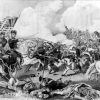

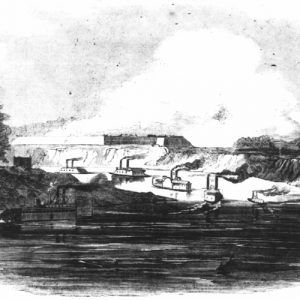
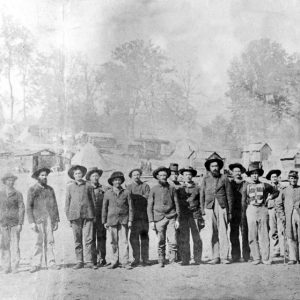
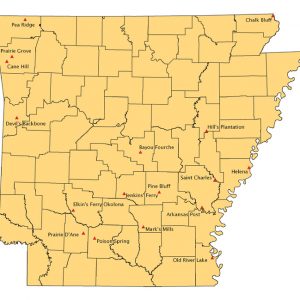
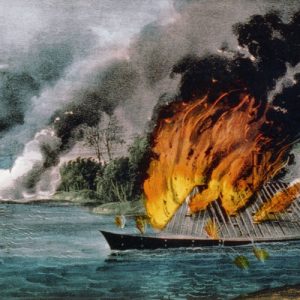
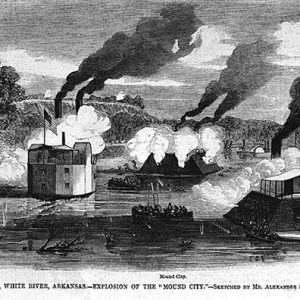
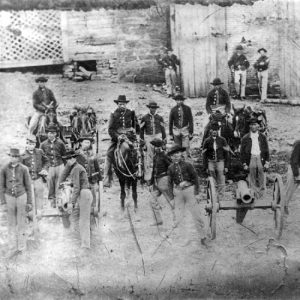
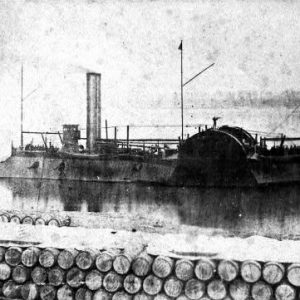
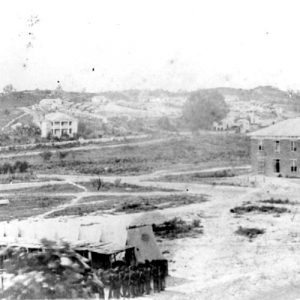
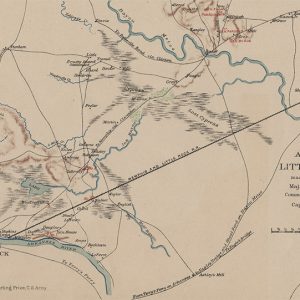
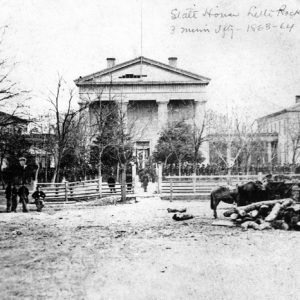
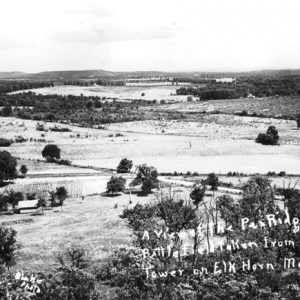

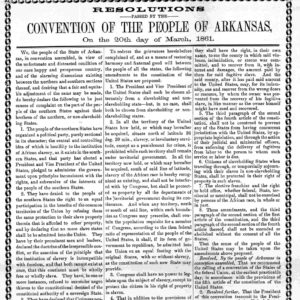

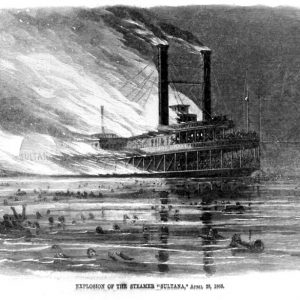






In 1887, a Confederate soldier’s grave was plowed up near a place called Kirkwood (maybe a community or plantation in Clark County near Okolona). The storyteller says the fight was on July 22, 1864, and he and several women buried several dead Confederates near where they fell. I find no fight in that area that would have had that many casualties except Elkin’s Ferry, but the dates don’t match.